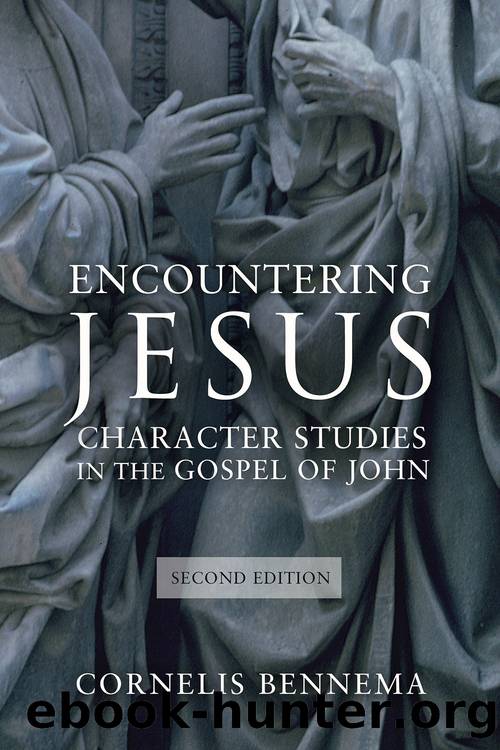Encountering Jesus by Cornelis Bennema

Author:Cornelis Bennema [Cornelis Bennema]
Language: eng
Format: epub
ISBN: 978-1-4514-8749-7
Publisher: Fortress Press
Published: 2014-08-31T16:00:00+00:00
A Jerusalem Crowd of Particular Religious Partisans in John 12
Whereas the crowds in John 6 and 7 consist of common people, John 12 presents a different group.[8] It is not a crowd of common Jerusalemites, because John identifies this crowd as “the great crowd of ‘the Jews’” (12:9). Nor is it a crowd of the religious authorities, because the crowd in 12:9 is contrasted with the religious authorities in 12:10-11, 18-19.[9] The crowd in 12:9 is more likely a great crowd of Judean Torah- and temple-loyalists, corresponding to the “many people from the countryside” who went up to the Passover feast of “the Jews” in Jerusalem (11:55).[10] Although initially this crowd of “the Jews” is favorable to Jesus (12:12-19), soon its attitude changes and ultimately it responds with rejection and unbelief (12:27-40)—typical of “the Jews” throughout. In fact, this crowd displays an attitude similar to the Galilean crowd. I will elaborate.
Just as in 6:14, 26, 30, the crowd of “the Jews” is focused on the spectacular: they have come to see the controversial Jesus and the resurrected Lazarus (12:9, 18). The Jewish authorities are afraid that, seeing Lazarus, the crowd may believe in Jesus—just as many of “the Jews” did when Lazarus was raised—therefore they plan to kill Lazarus too (12:10-11; cf. 11:45). When the crowd hears that Jesus is approaching Jerusalem, it hails him as the long-awaited messianic king (12:12-13). Jesus is given this rousing welcome because of the raising of Lazarus (12:17-18). While the crowd expects Jesus to be a political messianic leader who would liberate them from Roman oppression, Jesus’ action in 12:14-15 serves to correct their misunderstanding. Against the backdrop of Zechariah 9:9-10, Jesus is depicted not as a warrior-king but as a king who will destroy Israel’s war tools (including the war horse) and establish peace. Hence, the devotion and expectations of the crowd seem rather misplaced (cf. 6:14-15).
Jesus attempts to help the crowd overcome their misunderstanding and unbelief (12:29-30) but in vain. When he speaks of his impending salvific death, the crowd is scandalized, but once again Jesus urges the crowd to understand and believe in him lest the darkness overtake them (12:31-36; cf. 1:5; 8:12; 11:9-10). Finally, Jesus withdraws and John reveals that for all Jesus’ admonitions and miraculous signs, the crowd at large does not believe in him (12:37; cf. 6:36). The crowd’s unbelief fulfills the prophecy in Isaiah 53:1, which speaks of the messianic Servant who is rejected (12:38). John then reveals in 12:39-40 the reason for the crowd’s unbelief: the closed minds of “the Jews” prevent understanding, repentance, and salvation, and by rejecting Jesus and his message they remain blind, or, are plunged further into darkness (cf. 9:39-41).
Nevertheless, John mentions that, though the crowd at large is unbelieving, many from the crowd “believe” in Jesus (12:42). However, this “belief” appears inadequate. First, it is a “secret” belief since the fear of expulsion from the synagogue prevents the people from publicly confessing their belief (12:42). John implicitly criticizes such an attitude
Download
This site does not store any files on its server. We only index and link to content provided by other sites. Please contact the content providers to delete copyright contents if any and email us, we'll remove relevant links or contents immediately.
| Guides | New Testament |
| Old Testament |
The Five People You Meet in Heaven by Mitch Albom(2841)
Name Book, The: Over 10,000 Names--Their Meanings, Origins, and Spiritual Significance by Astoria Dorothy(2490)
Real Sex by Lauren F. Winner(2474)
The Holy Spirit by Billy Graham(2416)
The Secret Power of Speaking God's Word by Joyce Meyer(2253)
0041152001443424520 .pdf by Unknown(2220)
How The Mind Works by Steven Pinker(2213)
Ancient Worlds by Michael Scott(2102)
ESV Study Bible by Crossway(2093)
The Meaning of the Library by unknow(2067)
The Gnostic Gospels by Pagels Elaine(2026)
Churchill by Paul Johnson(2011)
MOSES THE EGYPTIAN by Jan Assmann(1971)
The ESV Study Bible by Crossway Bibles(1911)
Jesus by Paul Johnson(1887)
The Nativity by Geza Vermes(1848)
Ancient Near Eastern Thought and the Old Testament by John H. Walton(1846)
The Complete Dead Sea Scrolls in English (7th Edition) (Penguin Classics) by Geza Vermes(1840)
City of Stairs by Robert Jackson Bennett(1825)
